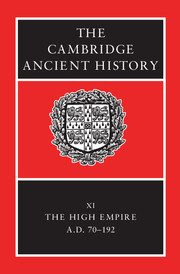Book contents
- Frontmatter
- PART I NARRATIVE
- PART II GOVERNMENT AND CIVIL ADMINISTRATION
- PART III THE EMPIRE
- PART IV ROME, ITALY AND THE PROVINCES
- PART Va ECONOMY AND SOCIETY
- 23 The land
- 24 Trade
- 25 Industry and technology
- 26 Commerce and finance
- 27 Demography
- 28 Status and patronage
- 29 Family and household
- PART Vb ART AND CULTURE
- Chronological Table
- BIBLIOGRAPHY
- Index
- 1 The Roman world in the time of Marcus Aurelius
- 7 The Danube provinces
- References
26 - Commerce and finance
from PART Va - ECONOMY AND SOCIETY
Published online by Cambridge University Press: 28 March 2008
- Frontmatter
- PART I NARRATIVE
- PART II GOVERNMENT AND CIVIL ADMINISTRATION
- PART III THE EMPIRE
- PART IV ROME, ITALY AND THE PROVINCES
- PART Va ECONOMY AND SOCIETY
- 23 The land
- 24 Trade
- 25 Industry and technology
- 26 Commerce and finance
- 27 Demography
- 28 Status and patronage
- 29 Family and household
- PART Vb ART AND CULTURE
- Chronological Table
- BIBLIOGRAPHY
- Index
- 1 The Roman world in the time of Marcus Aurelius
- 7 The Danube provinces
- References
Summary
Neither the fall of Nero nor the reign of Commodus marked an important turning-point in the history of private finance. During the one hundred and twenty-four years between their deaths developments in financial and banking life certainly took place, only some of which we can perceive. But some of them had begun before Nero, while others continued after Commodus. In order to understand the logic of these developments, it is necessary to bear in mind the enduring characteristics of Roman financial life, which (in many respects) continued up to the third century and even beyond.
It is this continuity which will be stressed in my first two sections. The first will be devoted to the financial activity of the senators, knights and other nobles, and to that of the intermediaries, money-changers and professional bankers. The second will briefly pose three important and extremely difficult questions. To what extent was the Roman empire monetized? What was the relationship between financial matters and the economy, that is the production and distribution of material goods and services? And how can we characterize the methods used by the various groups of financiers – did they change much from the last centuries of the Republic to the end of the high empire? The third section, like the first two, will deal with private finance, but with the intention of defining its evolution under the Flavians and Antonines. Can we speak of a decline of banking professions? What are we to make of the business affairs of the nobility? And are we fated to know nothing about the volume of transactions? Finally, the fourth and last section will deal with the manner in which the state and the cities did or did not intervene in these private financial matters.
- Type
- Chapter
- Information
- The Cambridge Ancient History , pp. 769 - 786Publisher: Cambridge University PressPrint publication year: 2000
References
- 5
- Cited by

